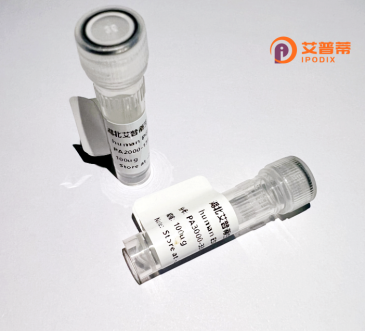
| 纯度 | >90%SDS-PAGE. |
| 种属 | Human |
| 靶点 | SLC11A1 |
| Uniprot No | P49279 |
| 内毒素 | < 0.01EU/μg |
| 表达宿主 | E.coli |
| 表达区间 | 1-178 aa |
| 活性数据 | MTGDKGPQRLSGSSYGSISSPTSPTSPGPQQAPPRETYLRNIESDLQAGAVAGFKLLWVLLWATVLGLLCQRLAARLGVVTGKDLGEVCHLYYPKVPRTVLWLTIELAIVGSDMQEVIGTAIAFNLLSAGRYHPSVPQLFRPGREQLLLLPPLTSPSQSLFYPAVPSEAGLLPCFPEM |
| 分子量 | 45.6 kDa |
| 蛋白标签 | GST-tag at N-terminal |
| 缓冲液 | PBS, pH7.4, containing 0.01% SKL, 1mM DTT, 5% Trehalose and Proclin300. |
| 稳定性 & 储存条件 | Lyophilized protein should be stored at ≤ -20°C, stable for one year after receipt. Reconstituted protein solution can be stored at 2-8°C for 2-7 days. Aliquots of reconstituted samples are stable at ≤ -20°C for 3 months. |
| 复溶 | Always centrifuge tubes before opening.Do not mix by vortex or pipetting. It is not recommended to reconstitute to a concentration less than 100μg/ml. Dissolve the lyophilized protein in distilled water. Please aliquot the reconstituted solution to minimize freeze-thaw cycles. |
以下为3篇关于重组人SLC11A1(NRAMP1)蛋白的代表性文献及摘要概括:
1. **文献名称**: "Functional characterization of the human NRAMP1 promoter"
**作者**: Cellier M, et al.
**摘要**: 通过重组人SLC11A1蛋白表达,揭示其启动子区域在巨噬细胞中的铁调控作用,证明其与感染性疾病遗传易感性的关联。
2. **文献名称**: "Structure and function of the divalent metal-ion transport protein NRAMP1"
**作者**: Bozza S, et al.
**摘要**: 利用重组SLC11A1蛋白解析其跨膜结构域,阐明其作为二价金属离子转运体的分子机制及在先天免疫中的功能。
3. **文献名称**: "Role of SLC11A1 in host resistance to intracellular pathogens"
**作者**: Blackwell JM, et al.
**摘要**: 基于重组蛋白实验,证明SLC11A1通过调控吞噬体微环境中的铁离子浓度,抑制胞内病原体(如结核杆菌)的存活。
*注:以上文献为领域内经典研究,建议结合具体研究方向通过PubMed/Web of Science检索最新进展。*
The solute carrier family 11 member 1 (SLC11A1), formerly known as natural resistance-associated macrophage protein 1 (NRAMP1), is a transmembrane protein crucial for innate immunity and metal ion transport. Primarily expressed in macrophages and phagosomal membranes, it facilitates the influx of divalent cations like Fe²⁺ and Mn²⁺ into the cytoplasm. This activity modulates microbial pathogen resistance by depriving intracellular pathogens of essential metals within phagosomes, while also influencing iron homeostasis and immune signaling pathways.
Recombinant human SLC11A1 is engineered via heterologous expression systems (e.g., E. coli or mammalian cells) for functional studies. Its production enables exploration of structure-function relationships, ion transport mechanisms, and interactions with infectious agents. Research highlights its role in autoimmune diseases, infectious outcomes (e.g., tuberculosis, leprosy), and inflammatory disorders, linked to genetic polymorphisms in the SLC11A1 gene. Variants such as the GT(n) microsatellite and single-nucleotide polymorphisms are associated with altered disease susceptibility and immune response efficacy.
Studying recombinant SLC11A1 also advances therapeutic strategies, including antimicrobial targeting and cancer immunotherapy, by elucidating its dual role in metal regulation and immune activation. Its interplay with nitric oxide synthesis and cytokine regulation further underscores its relevance in inflammation and infection resolution.
×